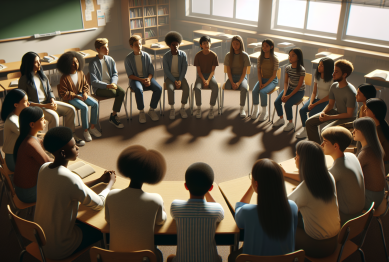In today’s rapidly evolving world, education has shifted focus. It’s no longer enough to simply collect information. Now, the true power lies in starting to connect ideas, rather than just amassing them. The process of connecting disparate pieces of knowledge fosters deeper understanding and promotes creativity. This article will explore how starting to connect ideas is shaping the future of education, unlocking deeper insights, and paving the way for more innovative solutions to complex problems.

Why Starting to Connect Ideas Matters in Education
The traditional model of education often revolves around students collecting information from textbooks, lectures, and online sources. However, learning how to start connecting that information in meaningful ways is what truly leads to long-term retention and understanding. Connecting ideas not only boosts memory but also aids critical thinking, enabling students to apply their knowledge effectively.
Active Learning: The Core of Starting to Connect
Active learning is a process that requires students to engage with material beyond passive absorption. By actively seeking connections between ideas, students deepen their understanding and improve their cognitive flexibility. Starting to connect concepts from different disciplines—such as math, science, literature, and history—creates a more integrated view of knowledge. This interdisciplinary thinking is crucial for tackling complex real-world challenges.
How to Start Connecting Information: Practical Steps for Educators
Educators play a significant role in encouraging students to start connecting ideas. It’s not just about teaching facts, but about guiding students through the process of making connections and thinking critically. Here’s how educators can facilitate connection-based learning:
1. Use Concept Maps to Help Students Start Connecting
A great tool for promoting connecting ideas is concept mapping. This technique involves visually organizing information and identifying relationships between various concepts. It helps students make connections between what they already know and what they are learning. It’s an excellent way to engage students in the process of active learning.
2. Foster Interdisciplinary Thinking
Encourage students to start connecting ideas from different disciplines. For example, a lesson on climate change could incorporate perspectives from biology, economics, and political science. By blending knowledge from multiple fields, students can develop a more holistic understanding of complex issues.
3. Collaborative Projects for Idea Sharing
Group work is another effective way for students to start connecting ideas. Collaborative projects allow students to exchange perspectives, challenge assumptions, and build on each other’s ideas. By discussing concepts in a group setting, students can learn to make connections they might not have considered on their own.
The Cognitive Benefits of Starting to Connect Ideas
When students start connecting knowledge, they engage in a more meaningful learning process. Here are some cognitive benefits of this approach:
-
Better Retention: Research shows that connecting ideas enhances memory retention. When information is linked to existing knowledge, it becomes easier to recall and apply in different contexts.
-
Critical Thinking: Making connections requires critical thinking. Students analyze relationships between ideas, evaluate their relevance, and synthesize information in new ways.
-
Problem Solving: Connection-based learning promotes the development of problem-solving skills. Students who learn to make connections between concepts are better equipped to tackle complex, real-world problems.
How Technology Facilitates Starting to Connect Ideas
In the digital age, technology provides students with countless tools to help them start connecting ideas. Here’s how:
1. Digital Collaboration Tools
Platforms like Google Docs, Microsoft Teams, and Slack allow students to work together, share resources, and discuss ideas in real time. These tools foster collaboration, enabling students to engage with each other and connect ideas across various topics.
2. Access to Diverse Resources
The internet gives students access to a vast array of resources, from online articles and videos to podcasts and research papers. By exploring various perspectives, students can begin to start connecting information from different sources and viewpoints.
3. Interactive Learning Platforms
Interactive platforms like Coursera, Khan Academy, and EdX allow students to engage in courses that require active participation. Many of these platforms incorporate quizzes, discussion forums, and group projects to encourage students to start connecting the material in a meaningful way.
Overcoming Barriers to Starting to Connect Ideas
While starting to connect ideas is essential, there are some challenges that students and educators may face in the process. Here are some common barriers and strategies to overcome them:
1. Information Overload
With so much information available, students may struggle to find relevant connections. Educators can help by guiding students to focus on key concepts and by providing frameworks for connecting information.
2. Lack of Time
In fast-paced educational environments, students may feel pressured to absorb information quickly, leaving little time to make connections. Teachers can address this by incorporating connection-based activities into lessons, rather than relying solely on lecture-based learning.
3. Fear of Making Mistakes
Students may hesitate to start connecting ideas for fear of making mistakes or drawing incorrect conclusions. Educators should encourage a growth mindset, where mistakes are seen as opportunities to learn and refine understanding.
Conclusion: The Future of Education is About Starting to Connect
The shift from collecting information to starting to connect ideas is transforming education. By helping students make connections between concepts, educators are fostering deeper learning and critical thinking skills that will serve students well beyond the classroom. As technology continues to evolve, the tools for starting to connect ideas will become even more powerful, allowing students to engage with material in innovative ways.
In an age where information is abundant, the real value lies not in collecting facts, but in connecting them. Whether through collaborative projects, interdisciplinary thinking, or digital platforms, the future of education depends on how well we can help students start connecting ideas and build a more interconnected understanding of the world around them.
Reference
1. Active Learning Increases Student Performance in Science, Engineering, and Mathematics –https://www.pnas.org/doi/10.1073/pnas.1319030111
2. The Benefits of Cross-Disciplinary Collaboration for Innovation – https://hbr.org/2015/12/the-benefits-of-cross-disciplinary-collaboration
3.The Role of Technology in Knowledge Sharing and Collaboration – https://edtechmagazine.com/higher/article/2019/11/how-technology-enhances-knowledge-sharing-and-collaboration









